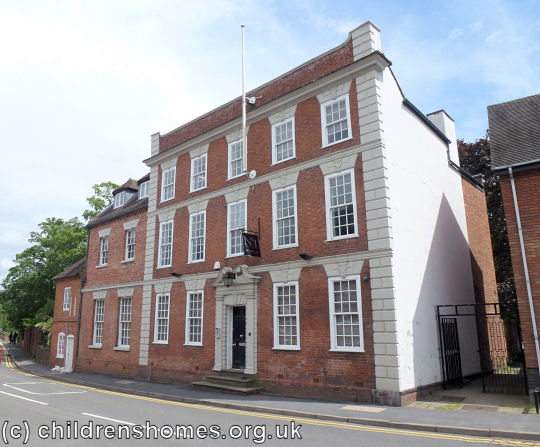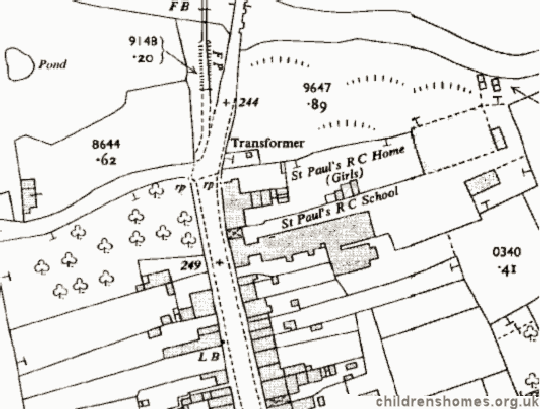St Paul's Home and School, Coleshill, Warwickshire
The St Paul's Home for Boys was set up by the Roman Catholic Diocese of Birmingham in 1884. It was established in order to take Catholic boys from the children's cottage homes at Marston Green operated by the Birmingham Board of Guardians. The Guardians, who administered the poor relief system in the city, had set up the cottage homes to house pauper children away from the workhouse.
Because of the Protestant nature of religious practices and teaching in the workhouse and cottage homes, the Catholic authorities were always concerned that young Catholics growing up in these institutions would be in danger of losing their faith. To counter this, a number of Catholic children's homes were set up in which Boards of Guardians could board out Catholic children. All such homes, of whatever religious denomination, were required to be certified for the purpose by the Local Government Board. St Paul's was formally accredited as a Certified School on November 4th, 1884.
Although there was no obligation on Guardians to make use of such homes, there were often attractions in their doing so. Catholic children in poor law institutions were not forced to attend Protestant services. However, making separate provision for them, for example to attend a local Catholic church, could be a burden that the Guardians would rather do without. Housing the children in a Catholic establishment could also be financially attractive. At Coleshill, for example, the Diocese offered the Birmingham Guardians a subsidy of five shillings a week towards the cost of each boy's upkeep if they agreed to place them in a new home at Coleshill. The Guardians agreed to the arrangement and the new St Paul's Home opened on November 10th 1884.
Located on the Lower High Street, the home was in a former tannery building, converted to house 68 boys aged from 2 to 16. The establishment was run by five members of the Sisters of Charity of St Paul the Apostle, with Mother Mecthilde Thelen taking overall charge.
In 1889, following the purchase of two adjoining cottages, the home was extended to provide extra dormitories and a dining room. By 1900, the expanding home could accommodate 180 boys. The Sisters now numbered fourteen, eight of whom performed teaching duties. In the same year, a swimming pool was created in the old tan pits which adjoined the home.

Former St Paul's Home premises, Coleshill, 2013. © Peter Higginbotham
Once established, the home's intake came not only from Birmingham but from other poor law authorities in the Midlands and places further afield, such as Liverpool. The length of time boys stayed at the home varied. Those whose family situations improved might then leave after a short stay, while others might remain until they reached working age, at which point they would be helped find employment in the area.
The school section of the home took on its own identity as St Paul's School. Local Catholic boys attended the school, as did children from the St Edward's Boys' Home in Coleshill, run by Father Hudson. Father Hudson, who was also the chaplain to the St Paul's Home, was appointed as its manager in 1912. In 1914, a junior school was opened on the St Edward's site for its younger boys. Those aged eleven or more continued to attend St Paul's, however, as did the girls from the new St Joan's Home opened in 1931. By this date, the St Paul's School, also known the Catholic Central School, was being attended by children from a wide area of the Diocese. It later became St Paul's High School, finally closing in 1970. The school buildings have now been demolished.

St Paul's Home and School, Coleshill, c.1955.
The St Paul's Home was closed in August 1925, by which time it had cared for around three thousand boys, including four wartime Belgian refugees. In 1932, the property became home to a school of massage, run by two Sisters who had trained at Guy's Hospital, London. From 1940, it resumed the name St Paul's and housed girls moved from the St Mary's House at St Joan's. It continued as a girls' home until the 1970s when it was adapted for use as a mother and baby home. In 1979, its neighbouring cottage was also converted to provide temporary accommodation and support for two young mothers. The St Paul's Home was finally closed in 1985 and the property sold. It is now used as office accommodation.
Records
Note: many repositories impose a closure period of up to 100 years for records identifying individuals. Before travelling a long distance, always check that the records you want to consult will be available.
The Father Hudson's 'Origins' service can provide access to records relating to children whom the Society placed for adoption or who were in its care, including those who were migrated to Canada or Australia. The establishments for which the Society may hold records are:
- Francis Way Mother and Baby Home, 124 Four Ashes Road, Bentley Heath, Knowle, Warwickshire.
- Woodville Mother and Baby Home, 176 Raddlebarn Road, Selly Oak, Birmingham.
- St Edward's Boys Home, Coventry Road, Coleshill.
- St George's and St James' Cottage Homes, Coventry Road, Coleshill.
- St Joan's and the Nursery, Coventry Road, Coleshill.
- St Paul's, High Street, Coleshill.
- St Andrew's, Blythe Road, Coleshill.
- St Vincent's Working Boys Hostel, 102 Moseley Road, Birmingham.
- Manresa Working Girls Hostel, Vernon Road, Edgbaston.
They may also have records if the Birmingham Diocesan Rescue Society placed you with:
- Maryvale Nursery, Old Oscott Hill, Kingstanding, Birmingham.
- Nazareth House, Rednal, Birmingham
- Pallotti Hall, Siddington, Nr Macclesfield
- St Joseph's, Jesson Road, Walsall.
To make an enquiry/application regarding records, download and complete the relevant application form from the Father Hudson's website. A charge is made for dealing with some types of enquiry.
Bibliography
- Higginbotham, Peter Children's Homes: A History of Institutional Care for Britain's Young (2017, Pen & Sword)
- Pinches, Sylvia M. Father Hudson and His Society: A History 1898-1998 (1998, Archdiocese of Birmingham Historical Commission)
Links
Except where indicated, this page () © Peter Higginbotham. Contents may not be reproduced without permission.


